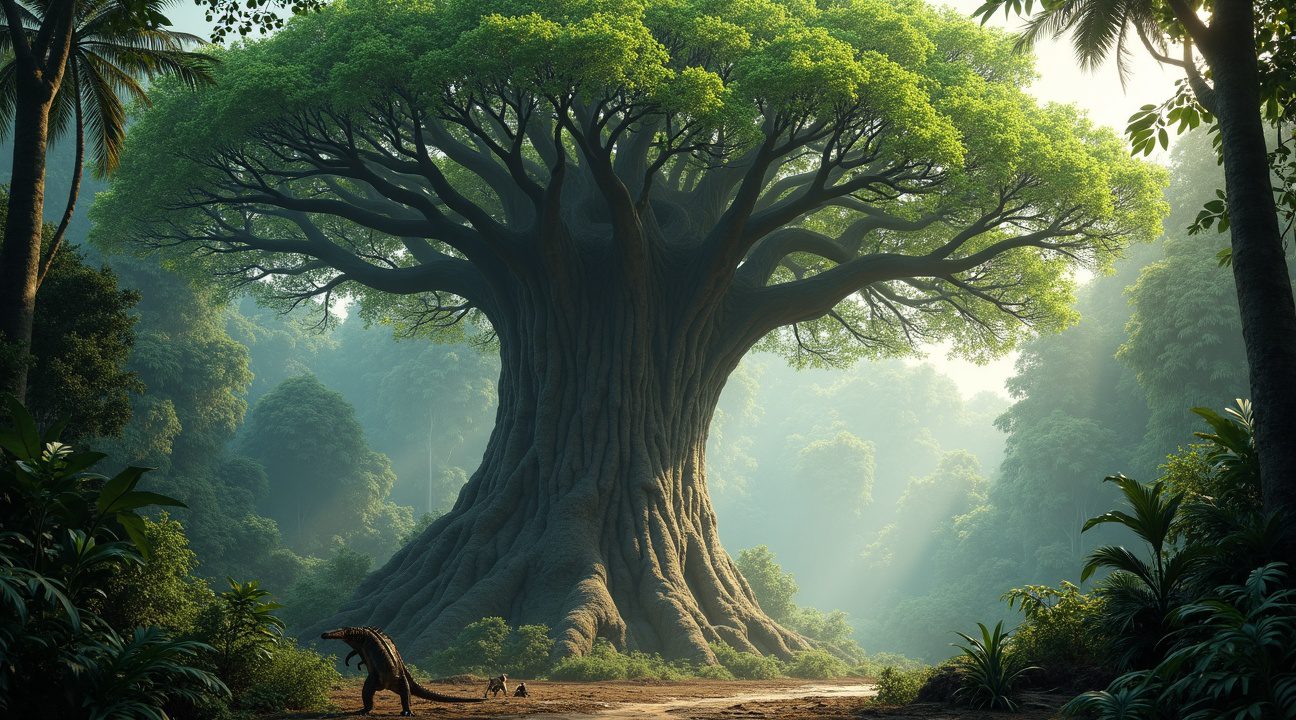Scientists have uncovered a remarkable 22-million-year-old prehistoric forest in Ethiopia’s Mush Valley that preserves an ancient African ecosystem dramatically different from today’s landscape.
This extraordinary discovery reveals giant extinct plants like Astropanax eogetem and provides unprecedented insights into Africa’s tropical past, while also containing evidence of human habitation dating back 150,000 years.
Key Takeaways
- The Ethiopian fossil forest dates back 22 million years and preserves exceptionally well-preserved plant specimens, including the extinct giant tree species Astropanax eogetem from the Araliaceae family.
- Archaeological evidence shows humans lived in African rainforests as early as 150,000 years ago, significantly earlier than the previously accepted timeline of 18,000 years.
- The ancient ecosystem supported remarkable biodiversity comparable to modern tropical rainforests, with complex canopy layers and sophisticated plant communities that thrived in humid, warm climates.
- Fossil analysis reveals specialized adaptation strategies that allowed ancient plants to survive dramatic climate changes, providing valuable insights for modern conservation and climate resilience efforts.
- This discovery fundamentally challenges previous assumptions about Africa’s environmental history and demonstrates that dense forest ecosystems were far more significant in prehistoric Africa than previously understood.
A Glimpse Into Africa’s Tropical Past
Researchers have made a groundbreaking discovery that reshapes our understanding of ancient African ecosystems. The fossil forest in Ethiopia’s Mush Valley preserves a complete snapshot of life from the early Miocene epoch. This site offers an extraordinary window into Africa’s past, revealing landscapes that differ drastically from the continent’s current appearance.
The preservation quality at this site exceeds expectations for fossils of this age. Scientists have recovered intact leaves, stems, and root systems that maintain their original cellular structure. These specimens provide detailed information about plant anatomy and ecological relationships that existed millions of years ago.
Ancient Human Habitation
Archaeological findings at the site extend far beyond plant fossils. Evidence of human habitation dates back 150,000 years, pushing back the timeline for human forest occupation by over 130,000 years. Stone tools and fire remnants indicate sophisticated adaptation to forest environments much earlier than previously documented.
Rich Biodiversity of the Miocene Forest
The ancient forest supported biodiversity levels that rival today’s most diverse tropical ecosystems. Multiple canopy layers created diverse microhabitats that supported various plant and animal species. This complexity demonstrates that African forests played a crucial role in early ecosystem development and species evolution.
Climate Revelations From Fossils
Climate data extracted from the fossils reveals dramatic environmental changes over millions of years. Plants developed remarkable adaptation strategies that allowed survival through multiple climate shifts. These findings provide valuable insights for modern conservation efforts and climate change research.
Challenging the Historical Narrative
The discovery challenges long-held beliefs about Africa’s environmental history. Dense forest ecosystems covered much larger areas of prehistoric Africa than scientists previously recognized. This expanded forest coverage significantly influenced continental climate patterns and species distribution during the Miocene epoch.
The Significance of Astropanax eogetem
Astropanax eogetem represents one of the most significant discoveries at the site. This giant tree species from the Araliaceae family grew to impressive heights and formed the forest canopy. Its extinction provides important data about how species respond to environmental pressures over geological time scales.
State-of-the-Art Imaging and Ongoing Research
Advanced imaging techniques have revealed microscopic details of plant tissue preservation. Cell walls, vascular systems, and even chloroplast remnants remain visible in many specimens. This level of detail allows researchers to understand plant physiology and metabolism from millions of years ago.
The research team continues excavations at multiple locations throughout the Mush Valley. Each new site reveals additional information about the extent and diversity of these ancient ecosystems. Future discoveries will likely expand our knowledge of prehistoric African environments and their global significance.
22-Million-Year-Old Forest Emerges from Ethiopian Valley
Deep within Ethiopia’s Mush Valley, researchers have uncovered one of Africa’s most extraordinary paleontological treasures. This prehistoric forest, dating back approximately 22 million years, offers an unprecedented glimpse into an ancient world that bears little resemblance to today’s landscape.
A Window into Ancient Africa’s Tropical Past
The Mush Valley site, positioned about 160 miles northeast of Addis Ababa, preserves what scientists consider one of the finest fossil records of early Miocene forests on the African continent. During this period, the region supported a dense, lush tropical ecosystem that contrasts dramatically with the modern grasslands and semi-arid conditions that characterize much of Ethiopia today.
Fossil evidence reveals towering trees and abundant vegetation that thrived in what was once a humid, warm climate. The preservation quality at this site allows researchers to reconstruct detailed environmental conditions from millions of years ago, providing crucial insights into how African landscapes have transformed over geological time.
Exceptional Preservation in an Unlikely Location
What makes this discovery particularly remarkable is the exceptional state of preservation found within the valley’s sedimentary layers. The fossil trees and plant materials retain enough detail for scientists to identify species and understand the ecological relationships that existed during the early Miocene period.
This ancient forest ecosystem supported a biodiversity that would seem foreign to anyone familiar with contemporary Ethiopian environments. The discovery challenges previous assumptions about the timing and nature of Africa’s transition from forested landscapes to the grassland savannas that dominate much of the continent today.
Scientists continue to excavate and analyze specimens from the site, with each fossil providing additional pieces to the puzzle of Africa’s climatic and ecological history. The Mush Valley forest represents a critical reference point for understanding how dramatic environmental changes have shaped the continent over millions of years.
Similar to how massive sinkholes can preserve ancient ecosystems, the geological conditions in Mush Valley created an ideal environment for long-term fossil preservation, allowing this 22-million-year-old forest to emerge as a testament to Africa’s dramatically different past.
Astropanax Eogetem: The Giant Tree That Time Forgot
Deep within Africa’s ancient fossil deposits, scientists have uncovered the remarkable remains of Astropanax eogetem, a tree species that vanished from Earth millions of years ago. This prehistoric giant represents one of the most significant paleobotanical discoveries in recent years, offering unprecedented insights into plant evolution during Earth’s distant past.
Astropanax eogetem belongs to the Araliaceae family, a diverse plant group that continues to thrive today through familiar species like ginseng and ivy. Modern botanists recognize this ancient tree as a close relative of contemporary Schefflera and Neocussonia trees, creating a fascinating bridge between prehistoric flora and present-day vegetation. The evolutionary connections reveal how certain plant lineages have persisted across geological time scales while others, like Astropanax eogetem, became extinct.
The fossil record preservation of this species stands out as truly exceptional. Scientists discovered leaf specimens with intact vein structures that remain clearly visible after millions of years of burial. These delicate features typically deteriorate quickly during fossilization, making their survival extraordinary. The preserved venation patterns provide crucial evidence for understanding how ancient plants conducted water and nutrients throughout their massive structures.
Pollen Analysis Reveals Ancient Secrets
Research teams identified unique pollen patterns within the fossilized remains that set Astropanax eogetem apart from its modern relatives. These microscopic structures display distinctive characteristics that allow precise classification and dating of the species. The pollen grains maintain their original morphological features, including surface textures and internal structures that serve as botanical fingerprints.
Laboratory analysis of these pollen samples has enabled scientists to:
- Establish accurate geological dating for the forest environment
- Confirm the species’ position within the Araliaceae family tree
- Identify specific reproductive strategies used by the ancient trees
- Compare evolutionary adaptations with modern plant species
- Reconstruct the prehistoric ecosystem’s biodiversity patterns
The pollen evidence suggests that Astropanax eogetem developed specialized reproductive mechanisms that differed significantly from its living cousins. These adaptations likely helped the species thrive in ancient African climates that bore little resemblance to today’s environmental conditions.
Plant evolution studies benefit enormously from discoveries like Astropanax eogetem because they fill critical gaps in the fossil record. The species represents a previously unknown branch of the Araliaceae family tree, demonstrating how diverse this plant group became during prehistoric periods. Understanding these extinct lineages helps scientists trace the evolutionary pathways that led to modern biodiversity.
The discovery parallels other remarkable finds in similar environments, including massive sinkholes containing ancient forests that preserve entire ecosystems from bygone eras. These geological formations act as natural time capsules, protecting delicate organic materials that would otherwise decompose completely.
Astropanax eogetem‘s exceptional preservation quality allows researchers to study plant anatomy in unprecedented detail. The leaf structures show complex venation patterns that suggest sophisticated water transport systems, indicating these trees grew to substantial sizes. The fossil evidence points to a species that dominated its ancient ecosystem, possibly forming extensive forest canopies that supported diverse wildlife communities.
Modern Araliaceae species display remarkable adaptability across different climates and habitats, from tropical rainforests to temperate woodlands. Astropanax eogetem likely possessed similar versatility, though its specific environmental preferences remain subjects of ongoing research. The species’ extinction probably resulted from major climatic shifts that altered African landscapes millions of years ago.
This extinct species continues to yield new information about prehistoric plant communities and their responses to environmental change. Each fossilized specimen adds another piece to the complex puzzle of ancient ecosystems, helping scientists understand how plants evolved and adapted throughout Earth’s dynamic history.

Biodiversity Paradise Lost to Time
The hidden prehistoric forest discovery in Ethiopia represents far more than ancient trees—it offers a glimpse into a biodiversity paradise that thrived millions of years ago. Fossils extracted from this remarkable site reveal an ecosystem teeming with life, suggesting species richness comparable to today’s most vibrant tropical forests.
Evidence points to this ancient forest supporting numerous species that no longer exist on Earth. The fossil record paints a picture of a complex ecosystem where giant plants shared space with countless other organisms, creating intricate food webs that sustained remarkable biodiversity levels. These findings challenge previous assumptions about prehistoric African ecosystems and their capacity to support diverse life forms.
Unlocking Ancient Ecosystem Secrets
The Ethiopian fossil record stands as one of Africa’s most significant botanical archives, providing crucial insights into tropical flora evolution. Researchers examining plant remains from this prehistoric forest have identified several key indicators of the ecosystem’s former richness:
- Preserved leaf fossils showing intricate vein patterns that indicate diverse photosynthetic strategies
- Root system impressions suggesting complex soil communities and nutrient cycling
- Pollen samples revealing flowering plant diversity that parallels modern rainforest communities
- Carbonized wood fragments demonstrating varied tree species with different growth patterns
- Seed and fruit fossils indicating sophisticated reproductive strategies among ancient plants
Each fossil fragment tells part of a larger story about how this ancient ecosystem functioned. The preservation quality allows scientists to reconstruct not just individual species, but entire community structures that supported this prehistoric biodiversity hotspot. Much like discovering a massive sinkhole with ancient forest features, this Ethiopian site reveals hidden worlds that existed long before human civilization.
The evolutionary history documented at this site provides critical data about how tropical ecosystems developed over geological time. Scientists can trace lineages of modern plant families back through these ancient specimens, revealing adaptation patterns that helped shape contemporary African flora. This prehistoric forest appears to have been a crucial evolutionary laboratory where many plant groups experimented with survival strategies that persist today.
Ancient trees discovered at the site show growth rings and structural adaptations that indicate seasonal climate patterns remarkably similar to current tropical regions. These patterns suggest the prehistoric forest experienced wet and dry seasons, supporting diverse plant communities adapted to varying moisture levels throughout the year. The ecosystem reconstruction based on these findings reveals a dynamic environment where species constantly adapted to changing conditions.
Fossil evidence indicates this ancient forest supported multiple canopy layers, from towering giants reaching impressive heights to understory plants specialized for low-light conditions. The vertical complexity mirrors modern tropical forests, suggesting similar ecological principles governed prehistoric ecosystems. This stratification would have created numerous microhabitats, each supporting specialized communities of organisms.
The site’s geological layers preserve a timeline spanning millions of years, allowing researchers to track how biodiversity changed over extended periods. Some species appear in multiple layers, indicating long-term ecosystem stability, while others show rapid evolutionary changes in response to environmental shifts. This temporal perspective provides invaluable insights into how ecosystems respond to climate variations over geological timescales.
Prehistoric biodiversity at this site extends beyond plants to include evidence of ancient fungi, bacteria, and other microorganisms that formed the ecosystem’s foundation. These microscopic fossils reveal complex soil communities that supported the giant plants above ground. The interconnected nature of these ancient communities demonstrates that prehistoric ecosystems operated with the same sophisticated biological relationships found in modern environments.
Current research continues to reveal new species from this ancient forest, with each discovery adding another piece to the biodiversity puzzle. The richness of life preserved at this site suggests that prehistoric Africa supported ecosystem complexity rivaling any modern tropical forest. These findings reshape our understanding of ancient Earth’s biological potential and provide crucial baseline data for contemporary conservation efforts.
Humans in the Ancient Rainforest: Evidence 150,000 Years in the Making
I’m fascinated by the groundbreaking discovery that fundamentally challenges everything researchers thought they knew about early human habitation patterns in Africa. This region presents some of the earliest known evidence of humans living in African rainforests, dating back as far as 150,000 years ago. Such findings represent the earliest secure evidence for human habitation in these environments, significantly predating previous estimates that held rainforest occupation only extended back about 18,000 years.
Archaeological discoveries in other parts of Central Africa, such as Gabon, have also yielded remarkable artifacts that paint a picture of sophisticated human adaptation. Stone tools, arrowheads, and various artifacts from humans dating between 25,000 and 150,000 years ago tell a compelling story of prehistoric ingenuity. The artifacts provide concrete proof that early humans weren’t just surviving in these challenging environments—they were thriving.
Archaeological Evidence of Human Innovation
The archaeological record reveals an impressive array of human-made objects that demonstrate remarkable resourcefulness. Researchers have uncovered the following significant discoveries:
- Pottery fragments that indicate sophisticated ceramic technology
- Human teeth that provide direct evidence of population presence
- Quartz tools crafted for specific forest-related tasks
- Jasper implements shaped for hunting and food preparation
- Dolomite shards used for various utilitarian purposes
Sediment analysis, combined with examinations of pollen, phytoliths, and leaf waxes, confirmed that these regions were heavily wooded and humid during these periods. This environmental reconstruction proves that early humans weren’t merely passing through these areas during drier periods—they were genuinely adapted to dense forest life.
Results show that early humans developed sophisticated strategies for surviving in conditions previously thought uninhabitable for prehistoric people. They learned to navigate the unique challenges of dense canopy cover, high humidity, and limited visibility while maximizing the forest’s abundant resources. Their ability to work with available materials like quartz and jasper demonstrates an understanding of local geology that would have taken generations to develop.
The discovery mirrors other remarkable findings in isolated environments, much like the massive sinkhole with an ancient forest inside that continues to yield surprising ecological insights. Both discoveries highlight how much researchers still don’t know about ancient ecosystems and human adaptation.
I find it particularly striking that these prehistoric communities developed specialized tool-making techniques specifically suited to forest environments. The stone tools found in these sites differ markedly from those discovered in savanna regions, indicating that humans weren’t simply applying existing technologies to new environments—they were innovating entirely new approaches to survival.
Pollen analysis has been crucial in reconstructing the exact environmental conditions these early humans faced. The data confirms that the forest cover was even denser than initially estimated, making human survival there an even more remarkable achievement. Phytolith evidence further supports the conclusion that these weren’t transitional woodland environments but genuine rainforest ecosystems with all their inherent challenges.
The implications extend far beyond simple chronology adjustments. This evidence suggests that human ecological adaptation was far more sophisticated and occurred much earlier than previously understood. Early humans demonstrated remarkable flexibility in colonizing diverse environments, developing specialized survival strategies that allowed them to exploit rainforest resources effectively.
These findings force a complete reevaluation of human migration patterns and environmental adaptation capabilities during the Middle Pleistocene period. The 150,000-year timeline places these forest-dwelling communities contemporary with some of the earliest modern human populations, suggesting that rainforest habitation wasn’t a late development but potentially one of humanity’s earliest ecological adaptations.

Rewriting Africa’s Hidden Environmental History
The Ethiopian fossil forest fundamentally transforms our understanding of Africa’s prehistoric environmental record. I’ve observed how this discovery shifts scientific attention from the traditionally studied open landscapes to reveal a complex tapestry of ancient forest ecosystems that flourished millions of years ago.
This fossil forest provides critical evidence about Africa’s environmental and ecological changes spanning tens of millions of years. Scientists can now piece together detailed climate patterns that shaped the continent’s biodiversity long before human civilization emerged. The preserved plant material offers direct testimony about ancient atmospheric conditions, rainfall patterns, and temperature fluctuations that influenced species development across vast timescales.
The discovery challenges long-held assumptions about African prehistoric research priorities. Scientists previously concentrated their efforts on open landscapes like the Sahara Desert, assuming these environments held the most significant archaeological and paleontological treasures. However, this Ethiopian forest demonstrates that Africa’s dense woodland areas contain equally valuable scientific information about ancient life forms and environmental conditions.
Unlocking Climate Resilience and Species Evolution
Ongoing research into these prehistoric forests reveals crucial insights about climate resilience and species adaptation mechanisms. Scientists studying the fossil evidence can identify specific strategies that ancient plants used to survive dramatic ecological shifts. These findings include:
- Specialized root systems that adapted to changing soil conditions
- Modified leaf structures that responded to atmospheric composition changes
- Reproductive strategies that ensured species survival during climate transitions
- Symbiotic relationships between different plant species that enhanced ecosystem stability
The relationship between early human populations and these ancient forest environments provides valuable lessons for modern environmental challenges. Archaeological evidence suggests that prehistoric communities developed sophisticated understanding of forest ecosystems, learning to work with natural cycles rather than against them.
Conservation efforts benefit significantly from this prehistoric ecological knowledge. Understanding how ancient forest systems maintained biodiversity through multiple climate changes offers practical strategies for protecting today’s endangered tropical ecosystems. The fossil record shows which species combinations created the most resilient forest communities, information that directly applies to modern reforestation and conservation planning.
Climate change research gains new depth through these ancient environmental records. The Ethiopian forest documents how ecosystems responded to prehistoric warming and cooling periods, providing crucial context for current climate models. Scientists can now compare modern environmental changes with historical patterns, identifying both natural resilience mechanisms and potential vulnerability points in contemporary ecosystems.
Species evolution studies receive unprecedented detail through the preserved plant material. Researchers can trace specific evolutionary adaptations that allowed certain species to thrive while others disappeared. This information helps predict which modern species might best survive current environmental pressures and which require immediate conservation intervention.
The discovery also reveals previously unknown biodiversity patterns across ancient Africa. Fossil evidence shows that prehistoric forests supported remarkably diverse plant communities, with species distributions that differed significantly from current patterns. This knowledge challenges assumptions about “natural” ecosystem configurations and expands possibilities for restoration projects.
Modern societies can apply lessons from these ancient forest communities to address contemporary environmental challenges. The prehistoric record demonstrates successful long-term ecosystem management strategies that maintained biodiversity through multiple climate shifts. These historical examples provide tested approaches for creating resilient landscapes that can adapt to changing conditions while supporting diverse species communities.
Research into this ancient forest continues to reveal new insights about Africa’s environmental history. Each discovery adds crucial information to our understanding of how complex ecosystems develop, maintain stability, and adapt to changing conditions over geological timescales.
The Ethiopian fossil forest represents more than just an archaeological curiosity. It provides a comprehensive environmental database that informs current conservation strategies, climate research, and ecosystem management practices. This prehistoric record offers hope that modern forest communities can develop similar resilience through careful study and application of ancient ecological principles.
Sources:
Blank


